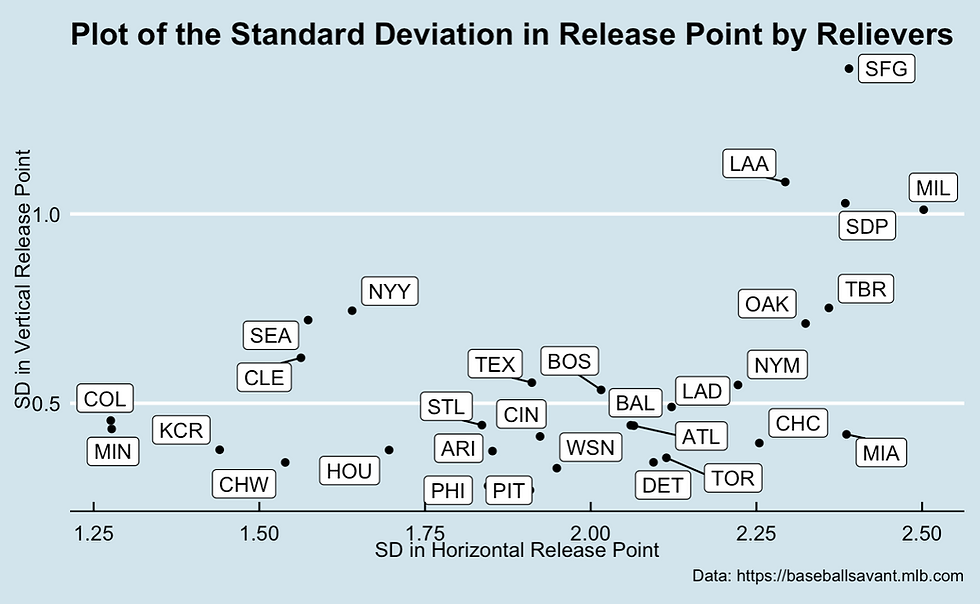Analyzing the Effect of Varying Arm Angles
- Jacob Bleiweis
- Sep 20, 2021
- 5 min read

(Stan Szeto/USA TODAY Sports)
Sports franchises are always searching for ways to get a leg up on the competition, often utilizing analytics to capitalize on market inefficiencies. to investopedia.com, “an inefficient market is one that does not succeed in incorporating all available information into a true reflection of an asset's fair price.” A notorious example of a team taking advantage of a market inefficiency is the Oakland Athletics, ran by GM Billy Beane, who used analytics to determine that on base percentage was a better metric for evaluating hitters than batting average, enabling the A’s to acquire undervalued hitters.
Finding market inefficiencies is very important for roster-building because it allows teams to get a lot of bang for their buck. It is especially important for organizations with fewer bucks to spend, such as the A’s and the Tampa Bay Rays, two teams notorious for utilizing analytics to help consistently field competitive teams with a low payroll.
Last season, while the Rays were playing the Los Angeles Dodgers, an organization which shows that using analytics and spending money are not mutually exclusive, the following graphic was shown by Fox during the broadcast.

This graphic shows that the Tampa bullpen consists of pitchers who throw from many different arm slots. Knowing their propensity for analytics, I wondered if Tampa had found an inefficiency in the relief pitcher market that allowed them to build one of the league’s best bullpens, which was first in WAR and fourth in FIP, for a low price. Does it help to have pitchers who throw from different arm slots in a team’s bullpen?
I used data from baseballsavant.mlb.com, as of July 30, to examine the release point of relief pitchers this season. Below are three graphs that show the release points for pitchers in the bullpens of the Rays, Giants, and White Sox. The graphics are from the catcher’s perspective, so right handed pitchers are on the left side.
From these graphs, you can see that the Rays and Giants both have pitchers that throw from many different release points, but the White Sox do not. Most of their relievers are righties who throw from similar points.
To help determine the variability in release point for a team’s bullpen, I calculated the standard deviation — how spread out the data points are — of the vertical and horizontal release points. Below is a graph that shows how varied the release points are for each team’s bullpen. Among teams with the largest variation in release point, both vertical and horizontal, are the Giants, Brewers, Angels, and Padres. The Twins, Rockies, Royals, and White Sox have some of the lowest variation in release point.

In order to determine whether or not release point variation impacts the success of a team’s bullpen, I ran several simple linear regressions with the standard deviation of release point, horizontal and vertical, as the explanatory variable and different pitching metrics as the response variable. The pitching metrics used were ERA, ERA-, FIP, FIP-, xFIP, xFIP-, and SIERA, and they were taken from Fangraphs.com (click here for more information on the metrics from Fangraphs.com).
Below is a chart that summarizes the findings from the simple linear regressions. It shows the p-value from the regressions of the standard deviation of horizontal and vertical release point and the metrics on the top. For example, the first p-value of 0.0022 suggests that there is a strong relationship between variation in horizontal release point and ERA, in this case it’s a negative relationship.

As seen in the table, there is a stronger relationship between vertical standard deviation and the pitching metrics compared to horizontal standard deviation. There is also a stronger relationship when ERA is involved compared to FIP (more on this later).
Below are some graphs that make it easier to visualize the data from the chart. The smaller the p-value, the steeper the line illustrating the trend.
The data shows that there is a correlation between having pitchers who throw from different arm angles and overall bullpen success; however, is the relationship causal? Should teams look to add pitchers who throw from different arm angles to make their bullpen better?
I only ran simple linear regressions; release point variation was the only variable that I tested. It is possible that there are other variables that are responsible for the changes in the pitching metrics, but I couldn’t think of any that would eliminate the effect of release point variation, other than talent level. Milwaukee’s Devin Williams and Josh Hader do not make the Brewer’s bullpen great because they throw from different arm angles, but because they each have some of the nastiest, most unhittable stuff in the league.
It seems unlikely that the effect that release point variation has on bullpen success was only observed because I did not take talent into account since we saw very strong correlations in the regressions. Unless, by coincidence, the most talented bullpens also happen to have the largest variation in release point, there is likely a causal relationship between having pitchers with different arm slots and bullpen success.
As mentioned earlier, there is a stronger relationship when ERA is used than when FIP is used. The difference between ERA and FIP is that FIP assumes that the result of a ball in play is random, that a pitcher has no control over whether or not their defense makes an out, so it only uses stats that pitchers control: home runs, hit-by-pitch, walks, and strikeouts.
To better understand why ERA had a stronger relationship than FIP, I regressed the standard deviation of horizontal and vertical release point against BABIP (batting average on balls in play). My hypothesis was that the data would show that more variation in release point would result in a lower BABIP, which would explain the stronger correlation to ERA. Below are the graphs showing vertical and horizontal release point variation and BABIP, which show a statistically significant (.05 significance level) linear relationship for both.
Although FIP is seen as the superior metric for evaluating pitchers, if having pitchers with different arm slots can result in a lower BABIP, the strong correlation with ERA would show the value of release point variation. However, it is possible that with a larger sample size, one that is more than just half a season, the correlation between release point variation and BABIP would be weaker. BABIP is typically random, so it is not very realistic to conclude that teams could control it by mixing up release points.
The research I did shows a correlation between release point variation and bullpen success, but more research is necessary in order to determine how strong. In the meantime, it looks as though the analytically focused teams, such as the Rays, may have found another market inefficiency to take advantage of.






















Comments